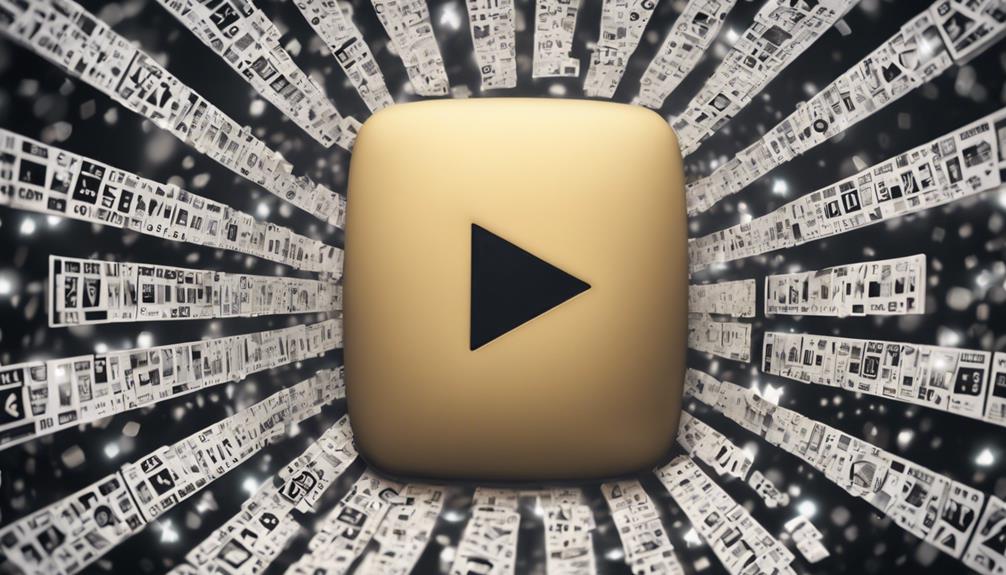
How many YouTube views does it take to make $100?
Have you ever heard about the YouTuber who earned over $100 with just 20,000 views on one of his videos?
It’s a common misconception that the number of views directly correlates with the amount of money you make on YouTube. Earnings from YouTube are not solely based on views, but also depend on various factors like viewer engagement, type of ads, and the audience’s geographical location.
So, if you’re curious about how many views it takes to make $100 on YouTube, you’re in for an intriguing exploration of YouTube’s complex monetization system.
Key Takeaways
- The number of views needed to make $100 depends on factors like ad type, viewer demographics, and CPM rates.
- Longer videos with more ads can potentially increase earnings, thereby reducing views needed to make $100.
- Earnings can also be influenced by partnerships with brands and channel sponsorships.
- Diversifying income streams can help mitigate the impact of ad-blockers and fluctuating ad revenue.
Understanding YouTube Monetization

Often, you may wonder how YouTube monetization works; it’s essentially a system where YouTubers can earn money from ads and YouTube Premium subscribers watching their videos. YouTube provides this platform for content creators, but it’s not just about uploading videos; it’s about effective monetization strategies and content optimization.
Your content optimization strategy should focus on increasing your views and watch time. YouTube’s algorithm favors videos that keep viewers on the platform longer. This means you’ll need to create engaging, high-quality content that your target audience wants to watch. Use analytics to understand what type of content performs best. Use this data to refine your content strategy, increasing your chances of attracting advertisers.
Monetization strategies can vary widely, but there are common practices successful YouTubers follow. You could opt for channel memberships, where your subscribers pay a monthly fee for exclusive content or perks. You might also consider merchandise shelf, where you can sell your branded products directly on YouTube. However, remember that these strategies work best with a large, engaged audience.
YouTube monetization is a dynamic process, requiring regular strategy adjustments based on performance data. It’s not a get-rich-quick scheme; it’s a platform for innovative, consistent content creators.
The Role of Advertisements
You’ll see that advertisements play a crucial role in determining how much you can earn from YouTube. The revenue generated from these ads is directly influenced by several factors, including the number of views, ad type, and viewer demographics.
However, it’s important to note that ad blockers can significantly impact your potential earnings, as they prevent ads from being viewed.
Understanding YouTube Ad Revenue
To grasp how YouTube ad revenue relates to your potential earnings, it’s crucial to understand the pivotal role that advertisements play in this equation. Ad revenue myths often mislead creators into believing that views alone drive earnings. However, it’s the ads served on these views that generate income.
YouTube uses a system called CPM (Cost Per Thousand views), where advertisers pay a specific amount for their ads to be displayed 1,000 times. Influencer partnerships can also bolster your earnings, as brands often pay creators to feature or endorse their products in videos.
Impact of Ad Blockers
While understanding the CPM model and influencer partnerships is essential, it’s equally vital to consider the impact of ad blockers on your potential YouTube revenue. Ad Blocker Penetration has been on the rise, with an estimated 27% of internet users employing ad blockers in 2020. This reduces the number of monetizable views, directly impacting your earnings.
Moreover, User Attitudes towards ads are shifting, with a growing preference for uninterrupted viewing. This further fuels ad blocker usage. Thus, if your content heavily relies on ad revenue, you might want to diversify your income streams. Innovation is key here. Explore alternative options like viewer donations, merchandise sales, and premium content to offset the declining ad views.
YouTube Partner Program Explained

Let’s now turn our attention to the YouTube Partner Program, the key to your content monetization. You should know the precise criteria to qualify, such as having at least 1,000 subscribers and over 4,000 watch hours in the past 12 months.
Once you’re eligible, understanding how to calculate your potential earnings becomes crucial to gauge your income from views.
Understanding YouTube Monetization
Diving into the world of YouTube monetization, you’ll find that it’s a key component of the YouTube Partner Program, a scheme designed to reward creators for their popular content through ad revenue.
Let’s illuminate this process using monetization policies and channel sponsorship as examples.
- Monetization Policies: YouTube sets specific guidelines that govern how creators earn. Non-adherence can lead to demonetization.
- Ad Revenue: You earn money when viewers interact with ads on your videos or watch premium content.
- Channel Sponsorship: Brands can sponsor your channel, providing a more stable income stream.
- Member Perks: Viewers can pay to become channel members, giving you a monthly fee in return for exclusive benefits.
Understanding these elements is crucial to maximizing your earning potential on YouTube.
Criteria for Eligibility
To unlock YouTube’s monetization benefits, you need to meet specific eligibility criteria set by the YouTube Partner Program. These Eligibility Requirements are designed to ensure a positive, innovative environment. First, you must live in a country where the program is available. Your channel needs at least 1,000 subscribers and 4,000 watch hours in the previous 12 months. Also, you must have an AdSense account.
Policy Violations have serious consequences – they could prevent you from joining or even lead to suspension from the program. So, ensure your channel strictly adheres to YouTube’s policies and guidelines, including copyright and community guidelines. It’s not just about acquiring views but maintaining a channel that consistently delivers engaging, policy-compliant content.
Calculating Earnings Potential
Understanding how much you can potentially earn through YouTube’s Partner Program requires a deep dive into the complex world of CPM (Cost Per Mille) and other pivotal metrics. It’s not just about views; viewer demographics and sponsorship opportunities also play significant roles. Here’s a basic breakdown:
- CPM: This is the amount you’ll earn for every thousand views. It varies significantly based on factors like content quality and viewer location.
- Viewer demographics: Advertisers pay more to reach certain demographics. Knowing your audience could boost your earnings.
- Sponsorship Opportunities: These can be a lucrative supplement to your ad revenue. Brands might pay you directly to showcase their products.
- Video Length: Longer videos can accommodate more ads, increasing your potential earnings.
YouTube’s Payment Algorithm

In the realm of YouTube, the algorithm used to calculate payments is a critical component you need to understand if you’re looking to make money. This algorithm isn’t stagnant and is frequently updated, leading to notable algorithm changes that can affect your earnings. Understanding these changes is vital in optimizing your videos for maximum revenue.
Viewer demographics also play a significant role in determining your payment. YouTube considers factors like the viewer’s age, location, and viewing preferences. Advertisers target specific demographics, and if your viewer base aligns with their target market, you’re likely to earn more. For example, if your viewers are primarily from a region with high advertiser demand, you could see a boost in your earnings.
Furthermore, the type of ads displayed on your videos also affect your income. Different ad types have different costs-per-view, and this is factored into YouTube’s payment algorithm. Ads that require viewers to watch for a certain duration or click on them generally pay more.
Innovation is crucial in this constantly evolving platform. Stay updated with the latest trends, algorithm changes, and viewer demographics to maximize your YouTube earnings.
The Importance of Audience Retention
While staying on top of trends and algorithms is key, don’t underestimate the power of audience retention when it comes to maximizing your earnings on YouTube. Audience retention is defined as the measure of how well your content keeps viewers watching. It’s not just about getting views, it’s about keeping your audience engaged.
Here are 4 crucial points to consider:
- Viewer Engagement: High audience retention means viewers find your content engaging. The longer viewers watch, the more YouTube’s algorithm favors your content. This can lead to higher rankings and increased visibility.
- Content Quality: Retention is directly linked to the quality of your content. High-quality, relevant content keeps viewers hooked, increasing your average view duration.
- Audience Loyalty: It’s not just about the first view. High retention rates often translate into repeat views, which can significantly boost your earnings.
- Algorithm Preference: YouTube’s algorithm prefers videos with high retention rates. This invariably leads to better search rankings and more suggested views.
To maximize your earnings, focus on improving these areas. Remember, in YouTube’s ecosystem, quality and engagement aren’t just buzzwords, they’re your pathway to more views and higher revenue.
The Impact of Video Length

Diving into the impact of video length, it’s essential to note that the duration of your YouTube videos can significantly influence your views, audience retention, and ultimately, your potential earnings. Analytics show that videos ranging from 7 to 15 minutes tend to perform the best, balancing the need for substantial content with the viewer’s attention span.
However, the video length is just part of the equation. Video quality effects also come into play. A longer video won’t hold viewers’ attention if the content isn’t engaging or the production quality is poor. Strive to maintain high standards of video and audio quality throughout the entire duration of your content.
Thumbnail significance shouldn’t be overlooked either. It’s the first thing potential viewers see and can influence whether they click on your video or scroll past it. A compelling, high-quality thumbnail can draw viewers in, even if your video is longer than the average.
Estimating Your Potential Earnings
Having considered the role of video length and quality in viewer retention, it’s now crucial to examine how these factors can help you estimate your potential earnings on YouTube. The Video Quality Impact and your Niche Selection play pivotal roles in this process.
- Ad Revenue: High quality videos often result in more view time, which in turn can increase your ad revenue. YouTube pays creators about $0.01 to $0.03 per view, but this can vary greatly.
- Viewer Engagement: Quality content encourages viewer interaction. More likes, shares, and comments can enhance your video’s visibility, potentially increasing your earnings.
- Niche Selection: Selecting a profitable niche is key. Some subjects attract higher-paying ads, while others have a larger, more engaged audience. Researching your niche thoroughly can optimize your income.
- Sponsorships and Partnerships: As your channel grows, so does the potential for sponsorships and partnerships. Businesses are willing to pay for access to your engaged audience, which can substantially boost your earnings.

